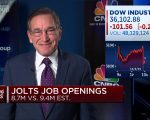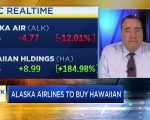
Federal Reserve Governor Christopher Waller said Tuesday he’s growing more confident that policy is in a place now to bring inflation back under control.
There was nothing in Waller’s prepared remarks for a speech in Washington, D.C., that suggests he’s contemplating cutting interest rates, and he noted that inflation currently is still too high. But he pointed out a variety of areas where progress has been made, suggesting the Fed at least won’t need to hike rates further from here.
“While I am encouraged by the early signs of moderating economic activity in the fourth quarter based on the data in hand, inflation is still too high, and it is too early to say whether the slowing we are seeing will be sustained,” he said. “But I am increasingly confident that policy is currently well positioned to slow the economy and get inflation back to 2 percent.”
A subsequent speech Tuesday morning from Governor Michelle Bowman offered a contrasting view, in which she reiterated her belief that more rate hikes likely will be needed as evolving dynamics keep inflation elevated.
The commentary comes two weeks before the rate-setting Federal Open Market Committee’s Dec. 12-13 policy meeting. Markets largely expect the committee to hold its key lending rate steady in a target range between 5.25%-5.5%. But Fed officials have stressed the importance of remaining vigilant on inflation and keeping their options open.
During the central bank’s ongoing battle against inflation, Waller has been one of the more hawkish members, meaning he has favored tighter policy and higher rates. However, he titled his Tuesday speech, “Something Appears to Be Giving,” a contrast to a recent speech titled “Something’s Got to Give.”
“I am encouraged by what we have learned in the past few weeks — something appears to be giving, and it’s the pace of the economy,” he said.
Waller cited a variety of areas where activity is moderating, from retail sales to the labor market to manufacturing. He also noted easing in supply chain pressures that were largely responsible for the initial jump in inflation, but he said that factor can’t be counted on to help bring inflation down further.
“Monetary policy will have to do the work from here on out to get inflation back down to 2 percent,” he said.
Waller noted easing in inflation gauges such as the consumer price index, which was flat in October and “what I want to see.” However, he said there will be multiple other data points in the next weeks that he will be watching closely, including Thursday’s report on inflation as measured by personal consumption expenditures.
Bowman cited several factors as likely to keep inflation elevated.
She echoed Waller’s point about supply chains and said further improvements in labor force participation could be limited, a situation that could boost pay as businesses struggle to find enough workers. Also, Bowman noted the uncertainty of future productivity gains due to education disruptions from the Covid pandemic.
A switch back to heavy services consumption also could boost inflation, as could some sectors of the economy that are not sensitive to higher rates.
“My baseline economic outlook continues to expect that we will need to increase the federal funds rate further to keep policy sufficiently restrictive to bring inflation down to our 2 percent target in a timely way,” Bowman said.







